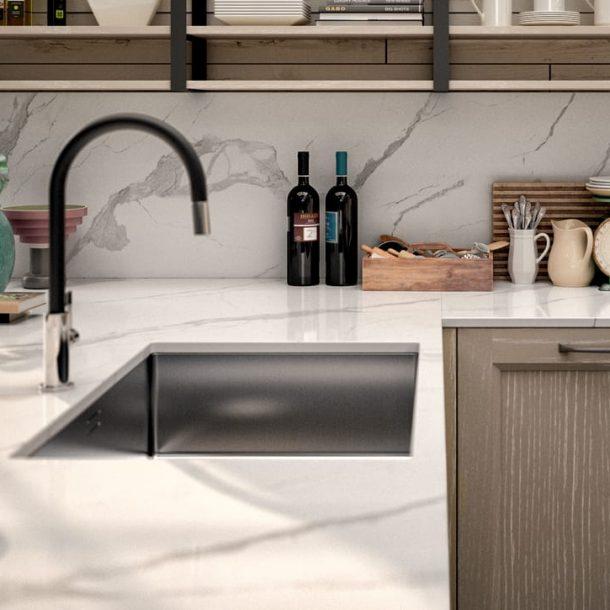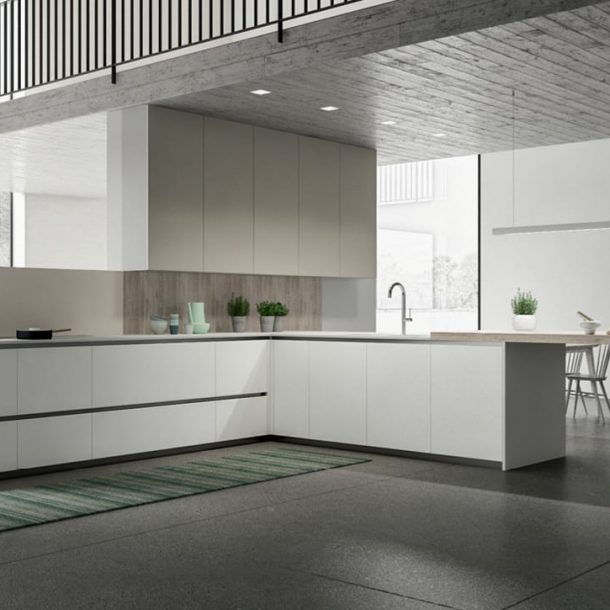
MATERIALS FOR KITCHEN WORKTOPS: WHICH TO CHOOSE
Materials for kitchen worktops must be resistant and durable. Let’s look at the best ones and find out how to choose the right solution for you.
A kitchen worktop is an essential element that very often determines the personality of the entire area, particularly when islands or peninsulas extend the kitchen into the living room. But when choosing the material for a worktop, aesthetics is not the only consideration. Functionality is important, taking into account where the worktop will be situated, the type and intensity of use, and users’ habits and needs.
Nowadays the market offers a practically infinite choice of materials, so choosing one is not an easy task. However, a functional, hygienic worktop that does not lose its initial good looks and resistance must have certain characteristics that determine its quality and, as we shall see, will condition our choice of material.
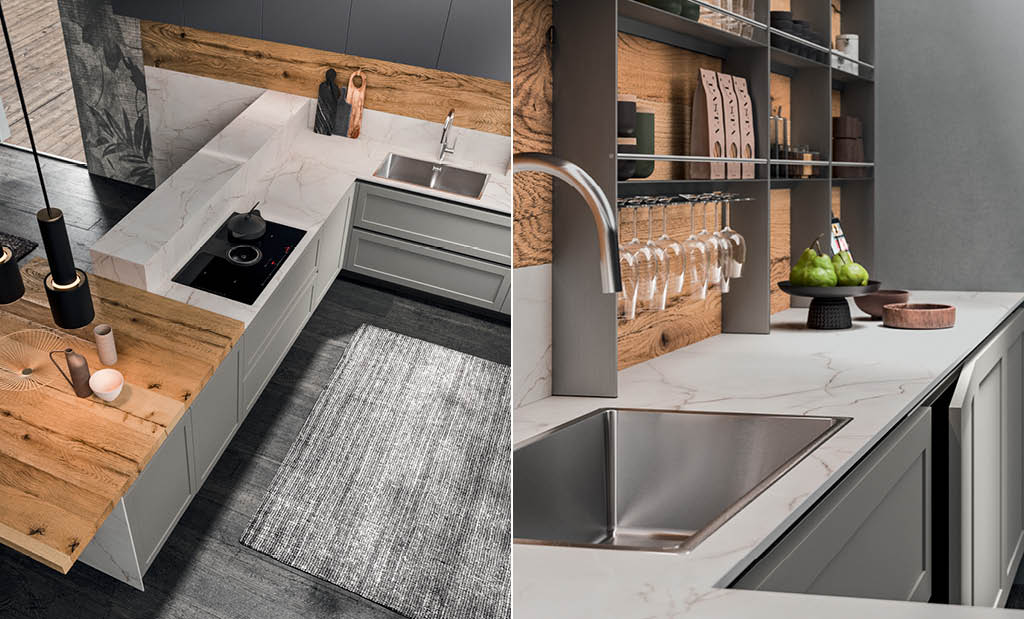
THE QUALITIES OF A GOOD KITCHEN WORKTOP
Kitchen worktops must be chosen with great care, considering not just aesthetics, but also and above all other fundamental characteristics essential for a quality worktop.
Although good looks are certainly important, features such as ease of cleaning and resistance are the ones that guarantee duration and stability over time.
So let’s see the fundamental qualities for a kitchen worktop.
Aesthetics
Appearance also counts, especially for an element that has a strong impact on its surroundings, like a kitchen worktop. Some materials are more customisable than others, in terms of colours and finishes. Stainless steel, for example, has practically no colour variations, but it can be polished, or have a satin or brushed finish. On the other hand, the different veining of marble brings a unique natural finish to a worktop. Other materials come in different colours with a choice of glossy or matt finishes.
Resistance
Kitchen worktops come under continuous strain because of how they are used and their position in contact with heat from cooking hobs and water from sinks. A good worktop should not be affected by cutting food directly on its surface without a chopping board. That means it must be resistant to cuts, scratches, scuffs and knocks. It must also resist heat and thermal shocks so that hot pans and oven trays can be placed on it without causing damage. Humidity is another issue, as it is important to avoid the appearance of mould along the edges of the sink. Finally, it must be resistant to natural acids such as those from lemons, vinegar and tomatoes, and the chemical ones in degreasing agents.
Practicality and Hygiene
These qualities are mainly determined by the porosity of the worktop material and its capacity to absorb liquids. It is also necessary for worktop material not to be sensitive to the most common cleaning products so that cleanliness and hygiene are ensured without the risk of water marks or fading colours. For even easier cleaning, the worktop should be a single element, with no joints or spaces where dirt could accumulate or liquids stagnate.
WHICH MATERIALS FOR A KITCHEN WORKTOP
Of the vast range of materials on the market, not all meet the needs of frequent or continuous use. Although not very functional, they are suitable for aesthetic solutions, for example in a holiday home kitchen that’s used sporadically for simple operations. The most suitable materials available for a kitchen worktop are:
- Laminate
- HPL Laminate
- Fenix
- Quartz
- Resin
- Stoneware
- Stainless Steel
- Marble/Granite
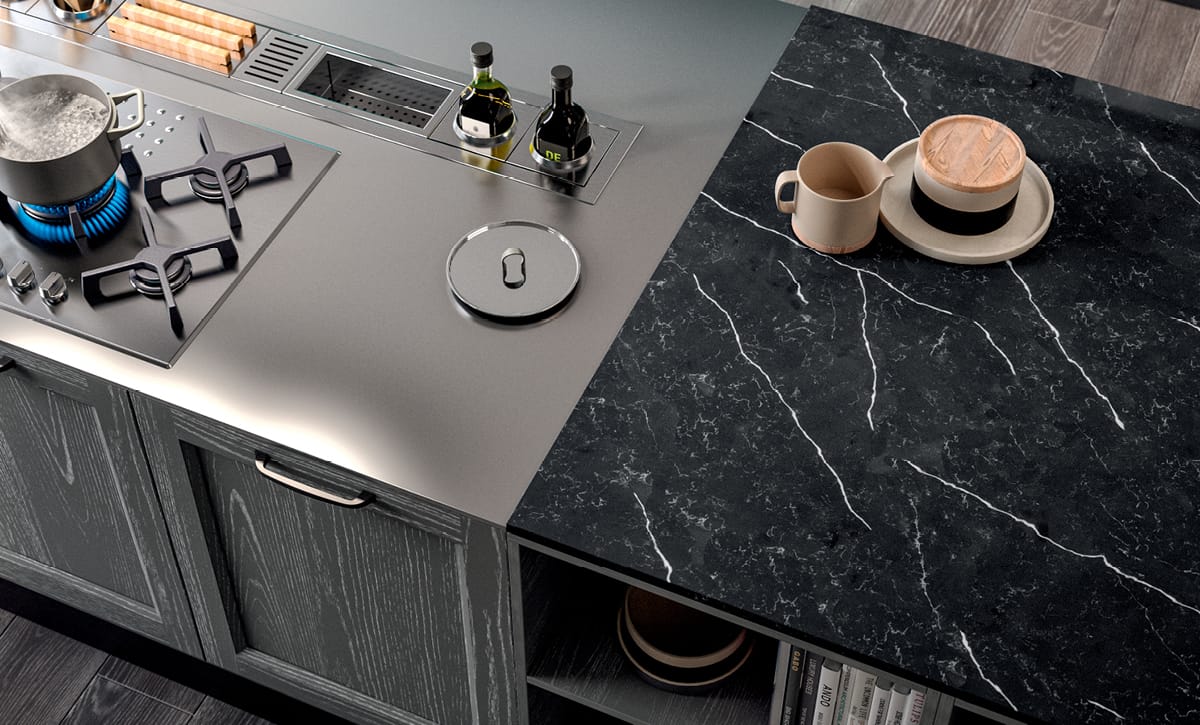
CHARACTERISTICS AND PROS AND CONS OF DIFFERENT MATERIALS
Now let’s analyse the main materials for kitchen worktops, one by one.
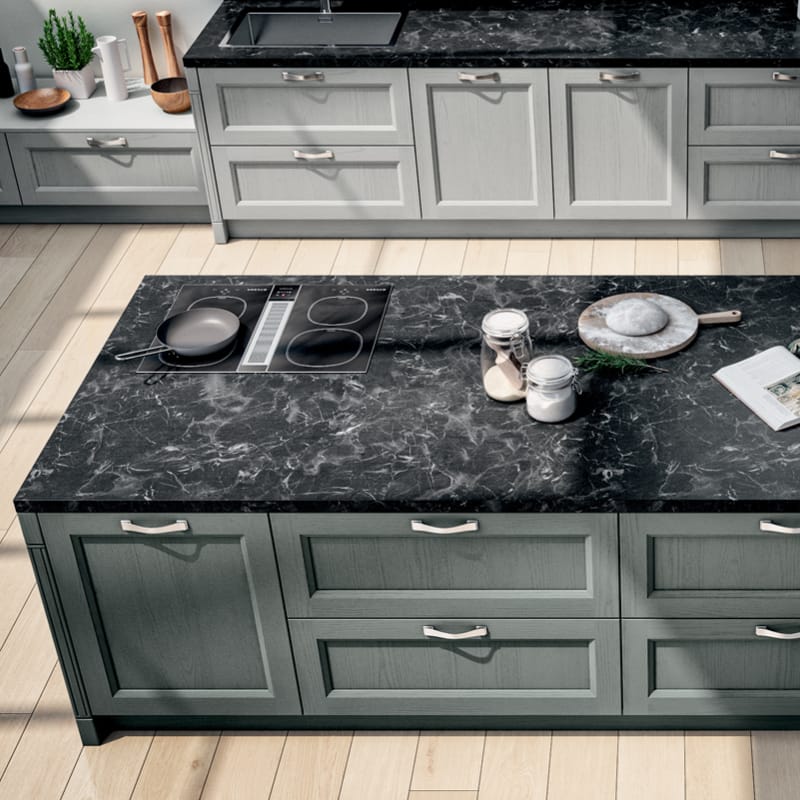
LAMINATE
An economical and extremely versatile material that replicates the aesthetics of materials that are more expensive but lack the characteristics that make them suitable for worktops, such as natural wood, for example. Laminate is highly resistant to scratches and knocks and is very easy to keep clean. However, it does need insulating from direct sources of heat, cannot be exposed directly to UV rays, which would fade the colours, and should not have joints in which humidity could accumulate.
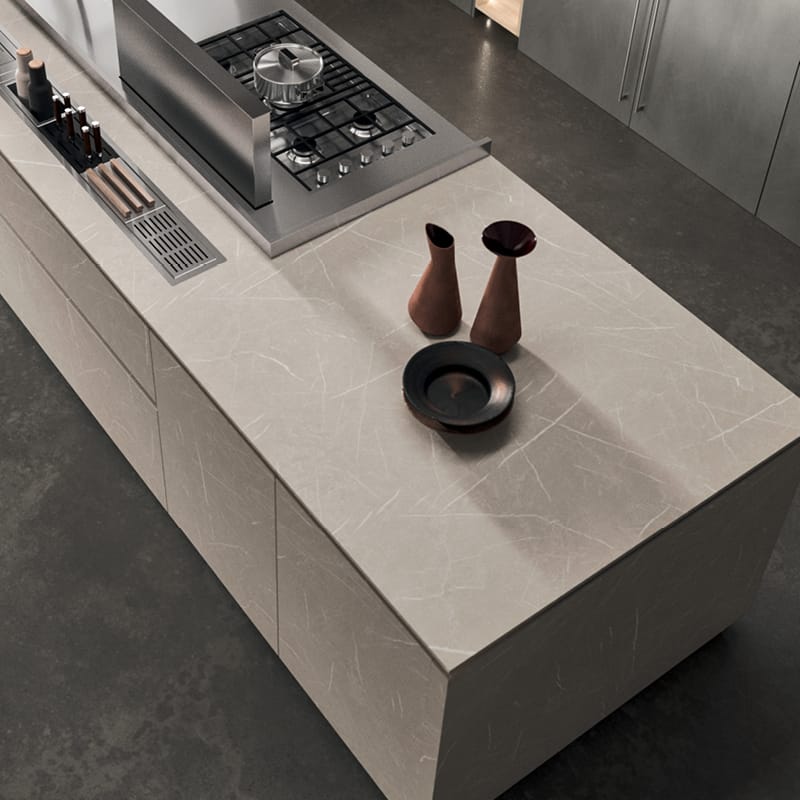
HPL LAMINATE
High Pressure Laminate is an evolution of traditional laminate, and is produced by subjecting layers of cellulose fibres and heat-setting resins to high pressure. The result is a non-porous, homogeneous material to which the final finish required by the customer is applied.
Compared to traditional laminate, HPL is resistant to liquids and heat, but it can also be treated to make it fire resistant or antibacterial. In addition, it is stable under light and does not discolour or fade if exposed to UV rays. It combines affordable costs and versatility with qualities such as strength and longevity. Gentili Cucine provides layered laminate with 15 different finishes that include the same ones used for cabinet doors in traditional laminate. In this way the customer can choose the kitchen worktop colour they prefer for their style of kitchen, which may be monochromatic or feature diverse colour combinations.
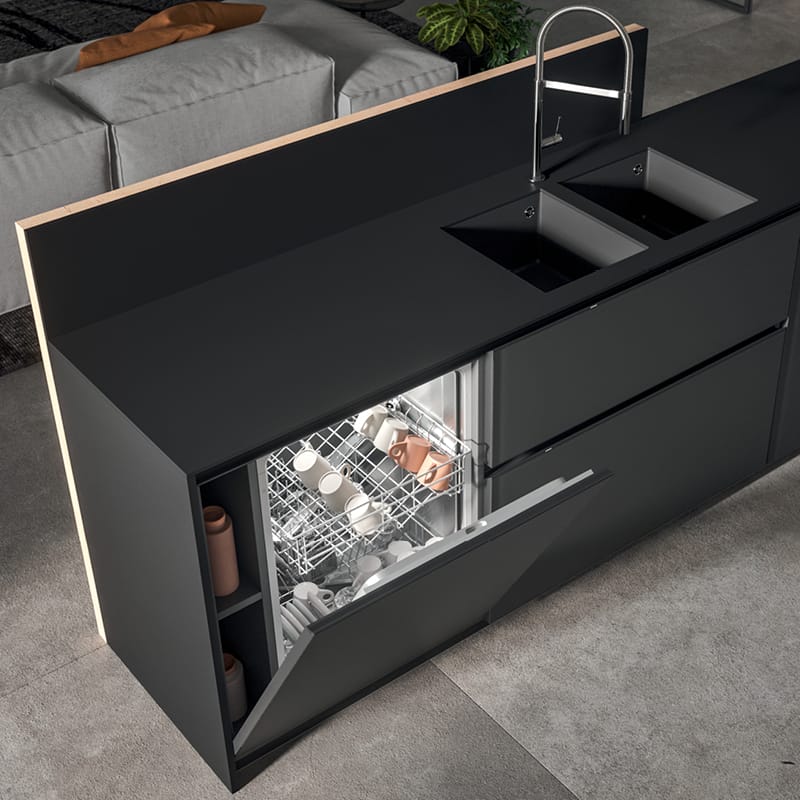
FENIX
The latest evolution for laminates, Fenix is produced with nanotechnologies and not only has the qualities of all laminates, but also special features, such as, for example, a smooth, matt finish that’s pleasant to touch and fingerprint proof. However, its main quality is the fact that scratches and scuffs can be repaired using heat, returning a damaged surface to its pristine condition. Hygienic, versatile, resistant and durable, Fenix is also great value for money, making it more and more popular for kitchen worktops.
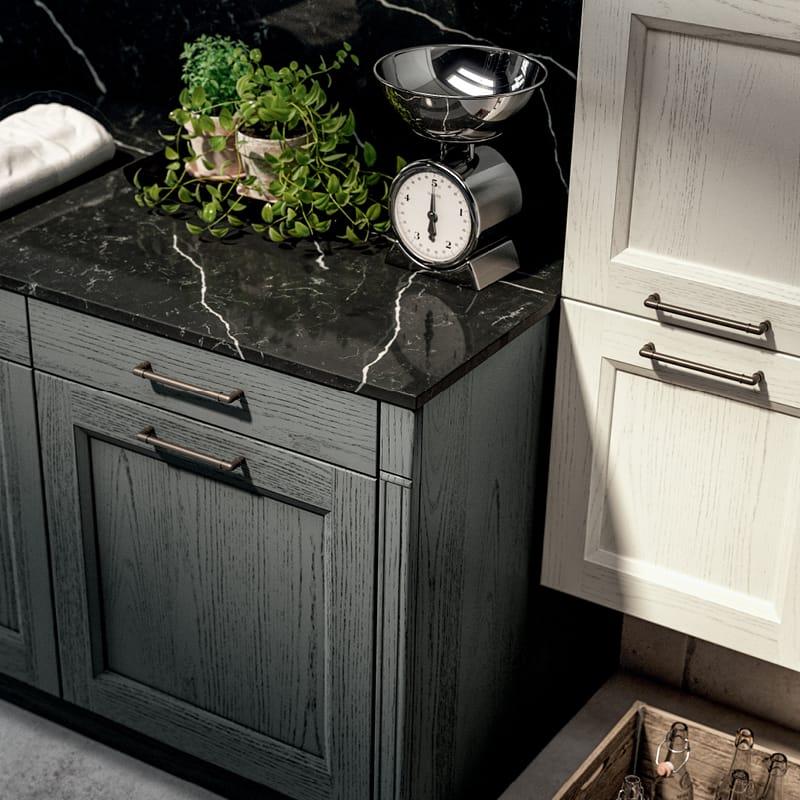
QUARTZ
Quartz agglomerates comprise high percentages (up to 95%) of quartz crystals combined with glass, resins and coloured pigments to enhance their aesthetics and strength. They can be used for customised kitchen worktops because the final texture is unique and unrepeatable, with a smooth non-porous surface that protects it from liquids and makes it hygienic and easy to clean. Quartz is resistant to acids, knocks, scratches and scuffs. However, it can be spoiled by thermal shock: use a pan stand in insulated material such as cork, wood or silicone when putting hot pans on the worktop.
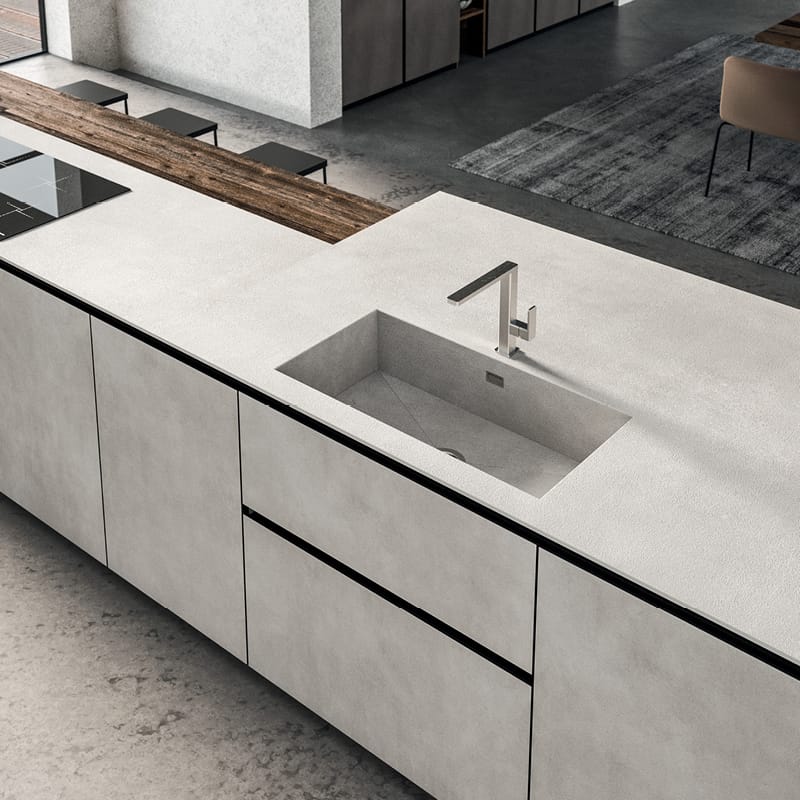
STONEWARE/LAMINAM
Stoneware is extremely resistant to acids and solvents, water repellant, and heat and stain proof, making it one of the most suitable materials for kitchen worktops. Gentili Cucine uses stoneware in 12 or 20mm thick slabs with a choice of 18 standard finishes. Exclusive processing of Laminam includes photocatalysis that makes the material self-cleaning. To this can be added extremely easy maintenance that does not compromise its characteristics even with intense use.
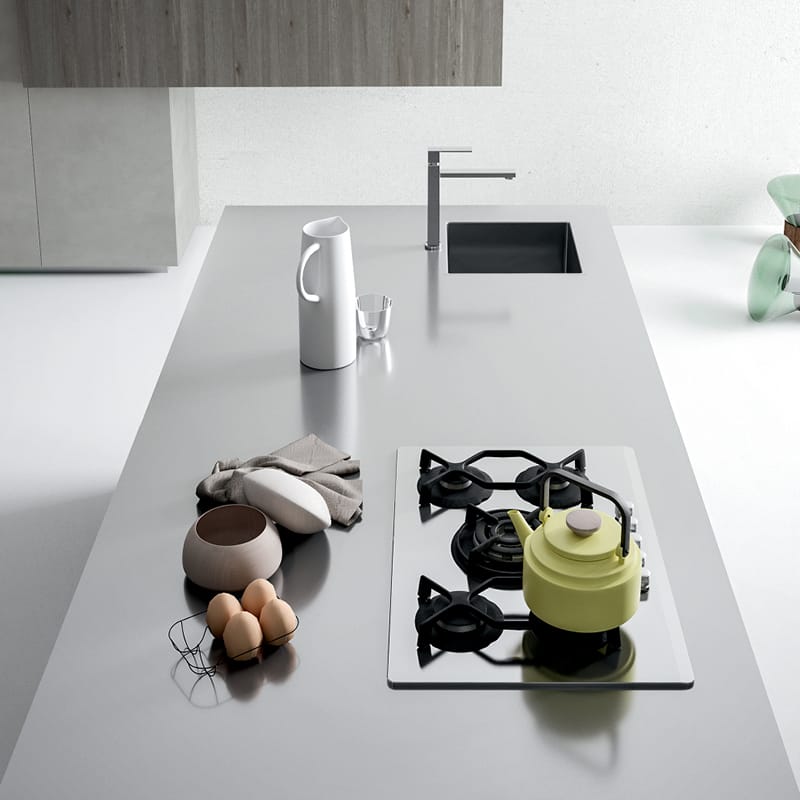
STAINLESS STEEL
The preferred material for professional kitchens and intensive use, due to its resistance and ease of maintenance. Its main qualities certainly include longevity and the fact that it is water repellant, easy to clean, hygienic and heat resistant.
Although its surface can be easily scratched and scuffed, it provides extremely practical, minimal style worktops that need just a little attention.
Stainless steel is available polished or with a satin or brushed finish. An advantage of the latter two solutions is that they are not easily marked by fingerprints or watermarks, but in any case a wipe over with a sponge will make the steel surface shine again.
RESIN
There are lots of types of resin for kitchen worktops, but in general it is a synthetic material that applies a continuous finish directly onto a stiff backing. That’s why resin is one of the most suitable solutions for renovating an existing, worn worktop or changing the style of the kitchen. Resins comprise heat-setting polymers that are pliant and create stunning effects in an almost infinite range of glossy, semi-glossy and matt finishes. Water repellant, easy to clean, resistant to knocks and scuffs, resin is a durable material, non-toxic and tolerant of chemicals and thermal shocks. As some resin compositions may be prone to scratching, it’s always a good idea to find out about the type of resin to be used and if necessary take care when choosing it for a kitchen worktop.
MARBLE/GRANITE
Natural stone has always been used for kitchen worktops because it is strong and easy to maintain. Marble is particularly suitable for direct contact with food and was traditionally used for kneading and rolling out dough in bakeries, pizzerias and kitchens specialising in freshly made pasta. Available in an almost infinite variety of colours and shades, it brings elegance and timeless exclusiveness to the kitchen. It can be attacked by acids and damaged by violent, direct knocks, but just a little attention keeps a marble worktop in pristine condition. Granite is slightly more porous, but it is more resistant than marble and brings with it the strong character typical of the traditional kitchens of the past. Impervious to chemicals and acids, granite is practically indestructible and will ensure a long life for any kitchen worktop that features it.
